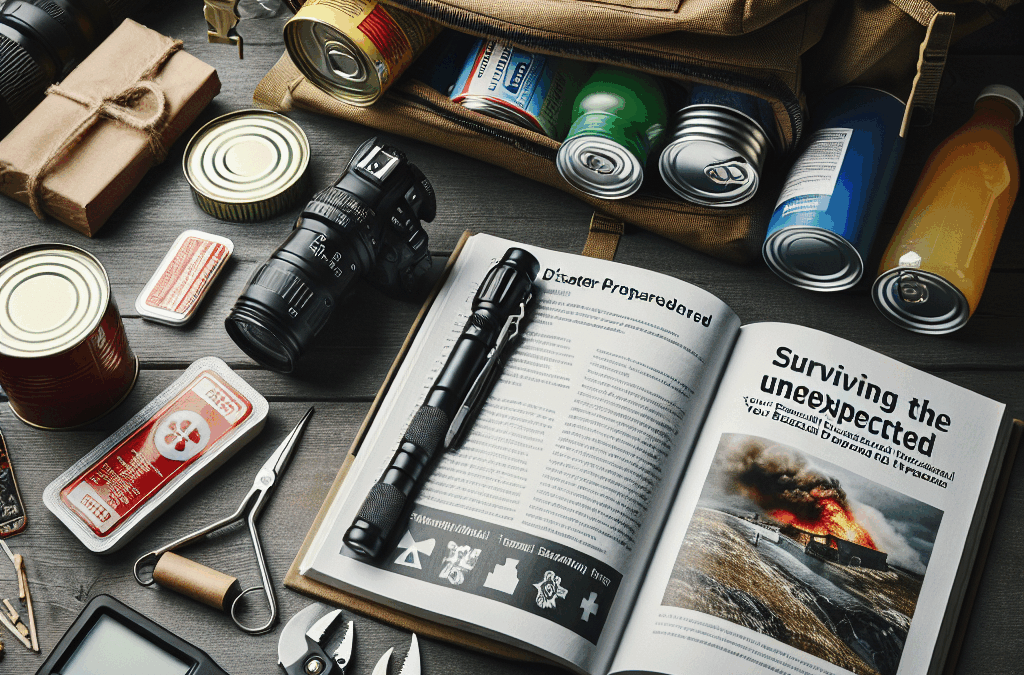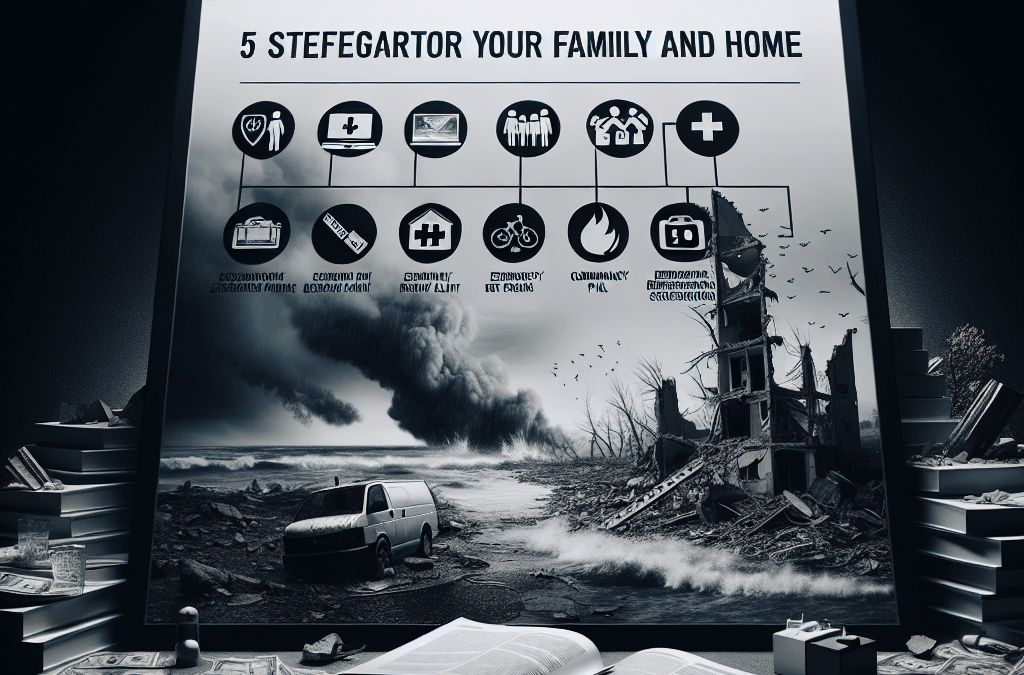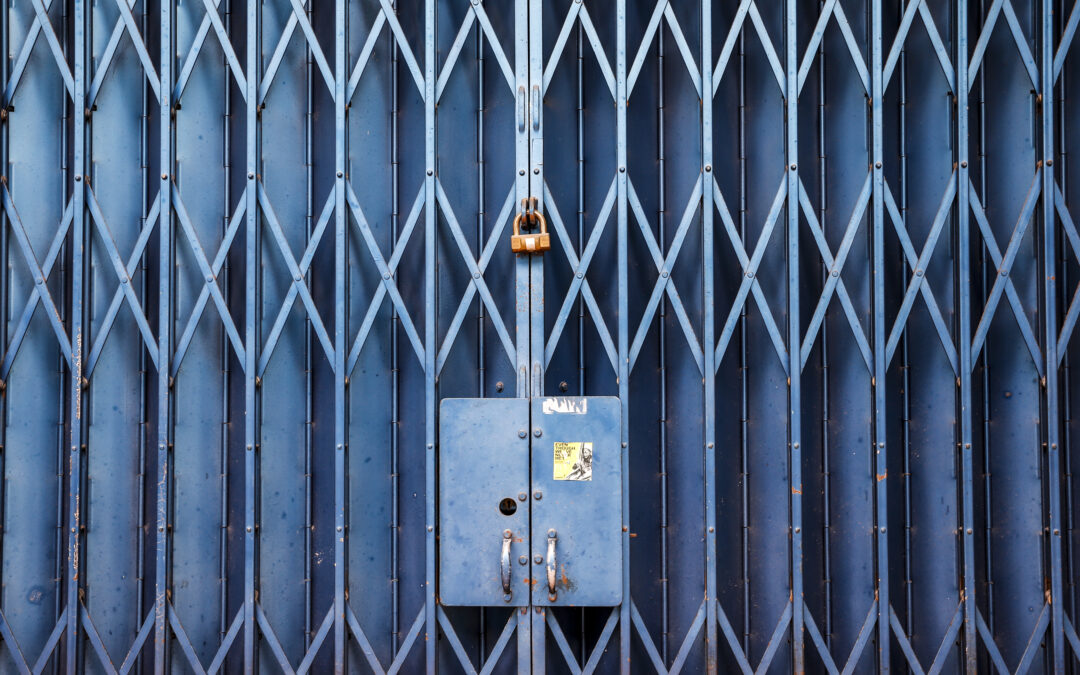
by Preparation | Jun 16, 2025 | Preparation Guide
Disasters can strike when least expected, leaving chaos in their wake. Whether it’s a natural calamity like an earthquake or hurricane, or man-made emergencies such as chemical spills, understanding the risks you face is the first step toward preparedness.
*Understanding the Risks: Identifying Potential Disasters in Your Area**
Every region has its own set of vulnerabilities. Begin by assessing your surroundings—are you located in a flood zone? Is your area prone to wildfires or tornadoes? Local government websites often provide hazard assessments that detail risks specific to your community. Familiarize yourself with historical data on disasters that have affected your area. Engaging with neighbors and local emergency management agencies can also yield valuable insights into what to expect and how best to prepare.
*Building Your Emergency Kit: Essentials for Every Household**
Once you’ve identified potential threats, it’s time to assemble your emergency kit. This should be a well-stocked collection of essentials designed to sustain you and your family for at least 72 hours during a crisis. Start with non-perishable food items—think canned goods, energy bars, and dried fruit. Don’t forget about water; aim for one gallon per person per day.
Other critical components include:
**First Aid Supplies:** Bandages, antiseptics, pain relievers.
**Flashlight and Batteries:** Power outages are common during disasters.
**Multi-tool:** A versatile tool can assist in numerous ways.
**Personal Documents:** Keep copies of important identification and insurance information.
**Clothing & Blankets:** Extra layers can keep you warm if temperatures drop unexpectedly.
Consider special needs as well—infants might require formula and diapers, while pets need food and medications too! Regularly check and refresh your kit every six months; it’s easy for items to expire or become outdated.
*Creating a Family Emergency Plan: Communication and Evacuation Strategies**
An emergency plan is essential for ensuring everyone knows what steps to take when disaster strikes. Gather your family members together and discuss potential scenarios—establish clear roles so each person understands their responsibilities. Designate a meeting point outside of your home where everyone can regroup if evacuation becomes necessary.
Communication is key; ensure each family member has access to important phone numbers written down or saved in mobile devices. With many people using smartphones today, consider apps that allow for group messaging even under limited connectivity circumstances.
Practice drills! Simulating emergencies helps familiarize everyone with the plan, making reactions instinctual rather than panicked when real situations arise.
*Staying Informed: Resources and Tools for Real-Time Updates**
In our fast-paced world, information is power—especially during crises. Equip yourself with reliable sources of real-time updates about impending disasters or emergencies affecting your area. Smartphone apps like FEMA or NOAA Weather provide timely alerts tailored to your location.
Local news stations often broadcast vital information through various media channels; tune into radio broadcasts if electricity fails or internet access is compromised. Consider investing in an NOAA weather radio—it could be the difference between safety and danger when seconds count.
Ultimately, being prepared fosters resilience within families and communities alike. By understanding risks unique to your environment, assembling essential supplies, creating actionable plans, and remaining informed through reliable resources—you arm yourself against the unexpected challenges life may throw at you! Embrace these preparations not just as tasks but as vital steps toward safeguarding lives!

by Preparation | Jun 16, 2025 | Preparation Guide
In a world where the unexpected can happen at any moment, disaster preparedness isn’t just an option—it’s a necessity. Natural disasters, health crises, and other emergencies can strike without warning, leaving families vulnerable and unprepared. By taking proactive steps today, you can ensure your family remains safe when disaster looms on the horizon.
Understanding Different Types of Disasters
Before you can effectively prepare for a disaster, it’s crucial to understand the various types that could threaten your area. Floods, hurricanes, wildfires, earthquakes, and pandemics each carry unique risks. Researching the specific hazards that could affect your community will help tailor your preparedness plan accordingly.
Creating a Family Emergency Plan
Crafting an emergency plan is essential for ensuring everyone in your household knows what to do during a crisis. Gather your family and discuss potential scenarios—what would you do if an earthquake struck or if a flood were imminent? Designate meeting points outside of your immediate neighborhood and establish clear roles for each family member. Make sure everyone has access to copies of important documents such as identification and insurance information.
Building an Essential Emergency Kit
A well-stocked emergency kit can be a lifesaver in times of need. Begin with the basics: water (one gallon per person per day), non-perishable food items, flashlights with extra batteries, first-aid supplies, clothing layers suitable for weather conditions, and hygiene products. Remember to update this kit regularly—check expiration dates on food items and replace batteries as needed.
Safeguarding Your Home: Structural Preparations
Your home should serve as a fortress during disasters. Strengthening its structural integrity is vital; this may include reinforcing roofs against high winds or securing heavy furniture to prevent tipping during earthquakes. Install smoke detectors throughout your home and check them monthly to ensure they work efficiently.
Staying Informed: Utilizing Technology and Alerts
In our tech-savvy world, staying informed is easier than ever before. Sign up for local alerts through government websites or download apps designed to provide real-time updates on emergencies in your area. Social media platforms often serve as valuable resources as well; follow local agencies for timely information about potential threats or evacuations.
Developing a Communication Strategy
Establishing clear communication channels among family members is crucial during chaos. Choose one method of communication that everyone understands—whether it be texting or using walkie-talkies—and practice it regularly. In addition to immediate family contacts, designate an out-of-area friend or relative who can serve as a point of contact in case local networks are compromised.
Disaster Drills: Practice Makes Perfect
Having a plan means little if no one knows how to execute it! Schedule regular disaster drills so that all family members become familiar with their roles in various scenarios. Consider involving neighbors too; forming cooperative plans increases community resilience.
Community Resources and Support Networks
Don’t underestimate the power of community support! Familiarize yourself with local organizations that offer assistance during disasters—these groups often provide resources like shelter or food distribution when emergencies occur. Connecting with neighbors can create stronger bonds while fostering mutual aid systems in times of crisis.
After the Disaster: Recovery and Rebuilding
When the dust settles after a disaster strikes, recovery begins—not just physically but emotionally too. Allow time for healing both individually and collectively within your household while also seeking professional help if needed. Stay connected with community resources designed specifically for recovery efforts so you won’t have to navigate rebuilding alone.
By following these ten key steps toward disaster preparedness today, you’ll equip yourself with the tools necessary not only to survive but thrive amidst uncertainty tomorrow!
by Preparation | May 6, 2025 | Preparation Guide
Disasters can strike at any time, and it’s essential to be prepared. Whether you live in an area prone to hurricanes or earthquakes, or if you simply want to be ready for anything that comes your way, disaster preparedness is crucial. In this article, we will cover everything you need to know about preparing for a natural disaster, including creating a plan, building an emergency kit, protecting your home, staying informed during a crisis, practicing your plan, and maintaining your readiness over time. Let’s get started!
Introduction to Disaster Preparedness
The first step in disaster preparedness is understanding what types of disasters are most likely to occur in your area. This knowledge will help you create a more effective plan and prepare accordingly. Some common types of natural disasters include hurricanes, tornadoes, floods, wildfires, and earthquakes. Once you have identified potential risks, it’s essential to take action to minimize their impact on yourself and your family.
The Importance of Having a Plan
Having a clear plan in place before a disaster strikes is critical. You should identify evacuation routes, safe places to shelter, and communication plans with loved ones. It’s also important to consider special needs, such as medications or medical equipment, and how they will be managed during a crisis. By having a well-thought-out plan, you can reduce stress and increase your chances of survival.
Creating an Emergency Kit
Another key component of disaster preparedness is building an emergency kit. Your kit should contain supplies that will last for at least 72 hours, including food, water, flashlights, batteries, first aid supplies, and clothing. It’s also a good idea to include items like games or books to keep children entertained during a long period without electricity or other amenities. Make sure to store your emergency kit in a convenient location where everyone knows where it is.
Preparing Your Home for Natural Disasters
In addition to personal preparedness, it’s essential to make sure your home is protected against natural disasters. For example, if you live in an area prone to wildfires, you may want to install fire-resistant roofing materials or remove flammable vegetation from around your property. If you live near the coast, you may want to invest in storm shutters or reinforce your doors and windows to withstand high winds. Taking these steps can help prevent damage to your home and reduce the risk of injury to your family.
Staying Informed During a Crisis
During a disaster, it’s vital to stay informed about current conditions and emergency response efforts. Listen to local news stations or check social media channels for updates on road closures, power outages, and other relevant information. Be cautious when using social media, however, as misinformation can spread quickly during a crisis.
Practicing and Maintaining Your Plan
Finally, regular practice and maintenance of your disaster preparedness plan is essential. Conduct drills with your family members so that everyone understands what to do in case of an emergency. Review your plan regularly and update it as needed based on changes in your living situation or local weather patterns. Additionally, make sure to restock your emergency kit every six months to ensure that all supplies are fresh and functional.
By following these tips, you can improve your level of disaster preparedness and feel confident that you and your family are ready for whatever life throws your way. Remember, being proactive and taking small steps today can make a big difference tomorrow.
by Preparation | Apr 23, 2025 | Preparation Guide
As a business owner, it’s essential to be prepared for any type of natural disaster that could impact your operations. A comprehensive checklist can help you ensure that you and your employees are ready to respond quickly and effectively in the event of an emergency. Here is a step-by-step guide on how to prepare your business for natural disasters:
Introduction to Disaster Preparedness
Disaster preparedness is not just about having insurance or backup systems; it’s also about understanding the risks and vulnerabilities of your business. By identifying potential threats early on, you can develop strategies to mitigate them before they become major issues. Some common types of natural disasters include hurricanes, floods, earthquakes, tornadoes, wildfires, and blizzards. Understanding which ones pose the greatest risk to your area will help you prioritize your preparation efforts.
Understanding the Risks and Vulnerabilities of Your Business
Conducting a risk assessment is an important first step in developing a comprehensive plan. Consider factors such as location, building structure, equipment, and supply chain when evaluating potential risks. You may want to consult with experts in disaster management or conduct research online to better understand the specific hazards that could affect your region. Once you have identified these risks, create a list of action items to address each one.
Developing a Comprehensive Plan and Checklist
Your disaster preparedness plan should outline the steps you will take to protect your employees, customers, and assets during a crisis. It should also detail how you will communicate with stakeholders and resume normal operations after the disaster has passed. Be sure to involve key personnel in the development process so everyone understands their roles and responsibilities.
Once you have developed your plan, create a checklist to ensure that all necessary tasks are completed. This includes securing physical infrastructure, backing up data, establishing communication protocols, and stockpiling supplies. Make sure to regularly review and update your plan to reflect changes in your business or the surrounding environment.
Building an Emergency Kit and Supply Chain
An emergency kit should contain everything you need to survive for at least 72 hours following a disaster. This includes food, water, medical supplies, flashlights, batteries, and other essentials. Don’t forget to consider the needs of individuals with special requirements such as those with mobility impairments or chronic health conditions.
You should also establish a contingency plan for your supply chain. Identify alternative suppliers or warehouse locations in case your primary source becomes unavailable due to a disaster. Establish clear communication channels with vendors and logistics providers to ensure that you receive timely updates on delivery statuses.
Testing and Training your Employees for Effective Response
Regular testing and training exercises are critical to ensuring that your team knows what to do in the event of a disaster. Conduct drills and simulations to test different scenarios and identify areas where improvements can be made. Encourage feedback from participants and use it to refine your plans and procedures.
In conclusion, being proactive about disaster preparedness can save lives and minimize damage to your business. Develop a comprehensive plan, build an emergency kit, establish a contingency plan for your supply chain, and train your employees for effective response. Remember, prevention is always better than cure!

by Preparation | Apr 23, 2025 | Preparation Call, Preparation Guide, Preparedness
The Danger of Complacency:
Wake up, people! Complacency is the silent killer of preparedness. When we get too cozy with the status quo, we lose our edge, our drive to take action and protect ourselves and our loved ones. We might brush off the need for kick-ass emergency plans, neglect to learn crucial survival skills, or fail to stock up on essential supplies. This leaves us wide open to the harsh reality that tougher times are just around the corner.
The Gathering Storm:
The warning signs are flashing red, folks! Economic indicators aren’t just hinting at a recession; they’re screaming about a potential global depression that could bring the world to its knees. Inflation is skyrocketing, debt is piling up, and job losses could be the final nail in the coffin for global markets. Geopolitical tensions are reaching a boiling point, with the drumbeats of war growing louder by the day. Major global conflicts are on the horizon, ready to tear apart supply chains, trigger massive shortages, and turn our daily lives upside down. Just imagine what your job or the local grocery store would look like in the aftermath of a global war. Climate change is unleashing hell on earth, with natural disasters becoming more frequent and intense, pushing our infrastructure to the brink and forcing people from their homes. The perfect storm is brewing, and it’s going to test our resilience like never before.
The Need for Vigilance:
In the face of this impending chaos, we can’t afford to be caught napping. We must be vigilant, always on the lookout for danger and ready to spring into action. Don’t let the temporary calm fool you; the harsh reality is waiting just around the corner. It’s time to get serious about preparing for the worst. Craft airtight emergency plans, master essential survival skills, and stockpile supplies like your life depends on it – because it just might.
Building Resilience:
True preparedness isn’t just about hoarding stuff. It’s about building unshakable resilience on every level – physical, mental, and emotional. We need to cultivate the skills and knowledge to adapt to any situation, whether it’s growing our own food or thriving off-grid. But it’s not just about physical toughness; we need to forge an iron will and unbreakable spirit. We must develop the mental and emotional strength to stare adversity in the face and come out swinging, no matter what challenges come our way.

by Preparation | Apr 23, 2025 | Preparation Call, Preparation Guide, Preparedness
Harvesting Wild Edible Plants and Medicinal Herbs – The Right Way
In the realm of preparedness identifying and collecting wild edible plants is an essential skill that provides both sustenance during times of need as well as access to natural remedies. However its important not only for survival but also for conservation purposes since over-harvesting can lead to plant population decline. This article delves into vital techniques on how best one should harvest leaves, fruits or roots without compromising their ability to thrive long term – a critical aspect in any sustainable living strategy!
The Importance of Sustainable Harvesting
Sustainable harvesting is a delicate balancing act between meeting human needs and safeguarding the health of our ecosystems. Overharvesting can lead to depletion in plant populations, disrupt natural habitats, and reduce accessibility for future generations. By mastering correct techniques through education and application we contribute towards preserving these vital resources that are essential for sustaining life on earth.
Harvesting Wild Plants and Medicinal Herbs – Techniques
Collecting Leaves
Opt for Sharp Tools: Avoid using dull knives or scissors when trimming leaves. This ensures a clean cut that reduces the risk of infection and minimizes harm to your plant.
To ensure your plants remain healthy and thriving during harvest season it is essential to practice selective picking. This means taking only a few leaves from each plant at a time so that they can continue their vital process of photosynthesis without interruption or harm. By doing this you’ll be able to maintain optimal growth conditions for all your greenery while still enjoying fresh herbs or greens as needed!
The ideal time for harvesting leaves is typically in the morning when dew has evaporated but before temperatures rise. This ensures that you collect turgid leaves with maximum nutrient content. By following this strategy you can maximize your yield and produce high quality herbs or medicinal plants.
Fruit Harvesting
When harvesting fruits, its essential to handle them with care. Bruising can occur if not done so delicately. To avoid this issue use both hands when twisting and pulling the fruit from its stem without damaging the plant. This will ensure that you get high quality produce while also preserving your plants health for future growth cycles.
Harvesting mature fruits is essential for optimal plant growth and nutritional benefits. Immature fruit can impede the plants reproductive process leading to reduced yields or poor quality produce. To avoid this issue make sure you wait until your crops are fully ripe before collecting them from the garden.
Root Harvesting
To minimize disruption when digging around roots use a specialized tool to carefully extract soil while leaving surrounding vegetation untouched. This approach ensures that you cause minimal disturbance and maintain the integrity of your garden or lawn area.
When it comes to propagating plants root division is an effective method that involves separating the roots and replanting them. This technique ensures a continuous supply of healthy plants while also promoting their growth. Its worth considering if you want your garden or indoor space filled with lush greenery all year round!
The optimal time for harvesting roots is during fall when the plants energy focuses on its root system. This period presents an ideal opportunity to extract medicinal properties from them effectively. Remember not to miss out!
Sustainable Harvesting – Best Practices
When foraging in nature its important to know exactly what you’re dealing with. Misidentifying plants can lead to consuming something that could be dangerous or even deadly! To avoid this risk use reliable field guides and apps when identifying flora. Another essential practice is following the “10% rule” which means only taking a maximum of ten percent from any given plant population at once – doing so helps preserve their numbers while still allowing them thrive over time. Finally make sure not leave behind any trace after harvesting by covering up holes dug into soil or dispersed plant material left behind during collection efforts. These simple steps will help ensure safe & sustainable gatherings from Mother Nature herself!
The Importance of Proper Harvesting Techniques
Wild edible plants and medicinal herbs are valuable resources that can sustain us during times of crisis. Sustainable harvesting practices ensure their availability for future use while also promoting environmental health by minimizing harm to plant populations and habitats. This supports wildlife dependent on these plants as well! By utilizing proper timing methods when collecting these natural remedies we maximize potency levels resulting in greater nutritional value overall – an essential aspect both dietary needs & medicine alike require!
Tips for Beginners – Practical Advice
Starting small is key when it comes to foraging. Begin by identifying a few easily recognizable plants and gradually expand your knowledge from there. Take note of local species’ specific harvest requirements as well so that you can make informed decisions about whats available in the area at any given time. Keep track of all plant types, locations, and dates through journal entries – this will help monitor growth patterns over time while also promoting sustainability practices within nature itself. Finally but most importantly always remember to respect both wildlife habitats & future generations alike when collecting food items from natural environments! By following these guidelines one can ensure responsible use of resources without harming ecosystems or compromising their own safety during outdoor activities like hiking or camping trips.
Mastering the correct harvesting techniques for wild edible plants and medicinal herbs is an essential skill that should be prioritized by anyone interested in preparedness. Not only does it provide a reliable source of food and medicine but also ensures sustainability for future use. By learning these methods and applying them you can enhance your survival skills while contributing to preserving our natural environment.
Important Information
Sustainable harvesting is crucial for preserving plant populations and maintaining ecosystem health. To achieve this goal, one must employ certain techniques such as using sharp tools like knives or scissors to cut leaves cleanly without damaging them further; selective picking of leaves instead of indiscriminately plucking all available ones at once; gentle handling while collecting fruits so that they remain intact throughout the process; careful use of digging equipment when extracting roots from plants without causing any harm to nearby vegetation; and finally adherence to proper timing by gathering leaves in the morning hours, matured fruit during their peak ripeness period, and roots during fall season only.
To ensure sustained growth within an area it’s also essential not take more than ten percent of a particular species population present therein – hence following what we call “The Ten Percent Rule.” This way you can preserve nature’s bounty for future generations too!
Harvesting plants can be a rewarding experience but its essential to identify them correctly and avoid any harmful species. Additionally leaving no trace behind is crucial in preserving the area for future use. By following these guidelines you’ll ensure that both nature and yourself benefit from your efforts.
To guarantee that your harvesting practices are both efficient and sustainable while contributing to preparedness efforts and environmental health follow these guidelines. By doing so you’ll be able to achieve optimal results without compromising the environment or future resources.








